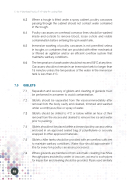Code of Veterinary Practice For Poultry Processing Plant 6.3 Where a trough is tted under a spray cabinet, poultry carcasses passing through the cabinet should not contact water contained in the trough. 6.4 Poultry carcasses on overhead conveyor lines should be washed inside and outside to remove blood, loose cuticle and visible contamination before entering the spin wash tank. 6.5 Immersion washing of poultry carcasses is not permitted unless in troughs or containers that are provided with either mechanical or ltered air agitation and/or an ef cient over ow system that maintains sanitary conditions. 6.6 The temperature of wash water should not exceed 18oC at any time. Carcasses should not remain in an immersion tank for longer than 15 minutes unless the temperature of the water in the immersion tank is less than 4°C. 7.0 GIBLETS 7.1 Separation and recovery of giblets and cleaning of gizzards must be performed in a manner to avoid contamination. 7.2 Giblets should be separated from the viscera immediately after removal from the body cavity and cleaned, trimmed and washed under a continuous ow or spray of water. 7.3 Giblets should be chilled to 4°C or below within an hour of their removal from the viscera and drained to remove free ice and water prior to packing. 7.4 Giblets should not be placed within a dressed poultry carcass unless enclosed in an approved sealed bag of polyethylene or securely wrapped in other approved materials. 7.5 Giblets chiller tanks should be provided with an over ow suf cient to maintain sanitary conditions. Water ow should approximate 1 litre for every ten poultry carcasses processed. 7.6 Where gizzards are transferred from automatic cleaning machines through pipes assisted by water or vacuum, access to such pipes for inspection and cleaning should be provided. Pipes used similarly 46
